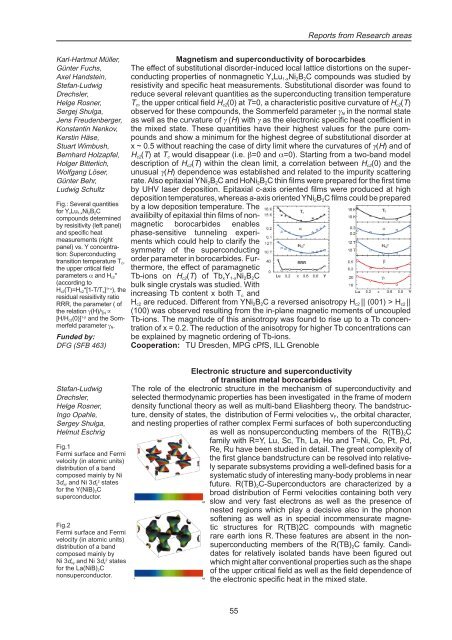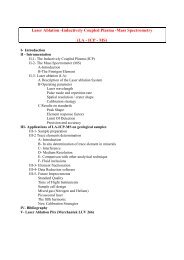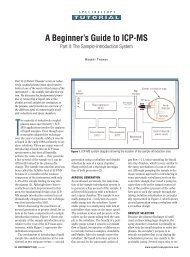Research area 1 Superconductivity and superconductors
Research area 1 Superconductivity and superconductors
Research area 1 Superconductivity and superconductors
Create successful ePaper yourself
Turn your PDF publications into a flip-book with our unique Google optimized e-Paper software.
Reports from <strong>Research</strong> <strong>area</strong>s<br />
Karl-Hartmut Müller,<br />
Günter Fuchs,<br />
Axel H<strong>and</strong>stein,<br />
Stefan-Ludwig<br />
Drechsler,<br />
Helge Rosner,<br />
Sergej Shulga,<br />
Jens Freudenberger,<br />
Konstantin Nenkov,<br />
Kerstin Häse,<br />
Stuart Wimbush,<br />
Bernhard Holzapfel,<br />
Holger Bitterlich,<br />
Wolfgang Löser,<br />
Günter Behr,<br />
Ludwig Schultz<br />
Fig.: Several quantities<br />
for Y x Lu 1-x Ni 2 B 2 C<br />
compounds determined<br />
by resisitivity (left panel)<br />
<strong>and</strong> specific heat<br />
measurements (right<br />
panel) vs. Y concentration:<br />
Superconducting<br />
transition temperature T c ,<br />
the upper critical field<br />
parameters a <strong>and</strong> H c2 *<br />
(according to<br />
H c2 (T)=H c2 *[1-T/T c ] 1+a ), the<br />
residual resisitivity ratio<br />
RRR, the parameter ( of<br />
the relation g(H)/g N µ<br />
[H/H c2 (0)] 1-b <strong>and</strong> the Sommerfeld<br />
parameter g N .<br />
Funded by:<br />
DFG (SFB 463)<br />
Magnetism <strong>and</strong> superconductivity of borocarbides<br />
The effect of substitutional disorder-induced local lattice distortions on the superconducting<br />
properties of nonmagnetic Y x Lu 1-x Ni 2 B 2 C compounds was studied by<br />
resistivity <strong>and</strong> specific heat measurements. Substitutional disorder was found to<br />
reduce several relevant quantities as the superconducting transition temperature<br />
T c , the upper critical field H c2 (0) at T=0, a characteristic positive curvature of H c2 (T)<br />
observed for these compounds, the Sommerfeld parameter g N in the normal state<br />
as well as the curvature of g (H) with g as the electronic specific heat coefficient in<br />
the mixed state. These quantities have their highest values for the pure compounds<br />
<strong>and</strong> show a minimum for the highest degree of substitutional disorder at<br />
x ~ 0.5 without reaching the case of dirty limit where the curvatures of g(H) <strong>and</strong> of<br />
H c2 (T) at T c would disappear (i.e. b=0 <strong>and</strong> a=0). Starting from a two-b<strong>and</strong> model<br />
description of H c2 (T) within the clean limit, a correlation between H c2 (0) <strong>and</strong> the<br />
unusual g(H) dependence was established <strong>and</strong> related to the impurity scattering<br />
rate. Also epitaxial YNi 2 B 2 C <strong>and</strong> HoNi 2 B 2 C thin films were prepared for the first time<br />
by UHV laser deposition. Epitaxial c-axis oriented films were produced at high<br />
deposition temperatures, whereas a-axis oriented YNi 2 B 2 C films could be prepared<br />
by a low deposition temperature. The<br />
availibilty of epitaxial thin films of nonmagnetic<br />
borocarbides enables<br />
phase-sensitive tunneling experiments<br />
which could help to clarify the<br />
symmetry of the superconducting<br />
order parameter in borocarbides. Furthermore,<br />
the effect of paramagnetic<br />
Tb-ions on H c2 (T) of Tb x Y 1-x Ni 2 B 2 C<br />
bulk single crystals was studied. With<br />
increasing Tb content x both T c <strong>and</strong><br />
H c2 are reduced. Different from YNi 2 B 2 C a reversed anisotropy H c2 || (001) > H c2 ||<br />
(100) was observed resulting from the in-plane magnetic moments of uncoupled<br />
Tb-ions. The magnitude of this anisotropy was found to rise up to a Tb concentration<br />
of x = 0.2. The reduction of the anisotropy for higher Tb concentrations can<br />
be explained by magnetic ordering of Tb-ions.<br />
Cooperation: TU Dresden, MPG cPfS, ILL Grenoble<br />
Stefan-Ludwig<br />
Drechsler,<br />
Helge Rosner,<br />
Ingo Opahle,<br />
Sergey Shulga,<br />
Helmut Eschrig<br />
Fig.1<br />
Fermi surface <strong>and</strong> Fermi<br />
velocity (in atomic units)<br />
distribution of a b<strong>and</strong><br />
composed mainly by Ni<br />
3d xy <strong>and</strong> Ni 3d z2 states<br />
for the Y(NiB) 2 C<br />
superconductor.<br />
Fig.2<br />
Fermi surface <strong>and</strong> Fermi<br />
velocity (in atomic units)<br />
distribution of a b<strong>and</strong><br />
composed mainly by<br />
Ni 3d xy <strong>and</strong> Ni 3d z2 states<br />
for the La(NiB) 2 C<br />
nonsuperconductor.<br />
Electronic structure <strong>and</strong> superconductivity<br />
of transition metal borocarbides<br />
The role of the electronic structure in the mechanism of superconductivity <strong>and</strong><br />
selected thermodynamic properties has been investigated in the frame of modern<br />
density functional theory as well as multi-b<strong>and</strong> Eliashberg theory. The b<strong>and</strong>structure,<br />
density of states, the distribution of Fermi velocities v F , the orbital character,<br />
<strong>and</strong> nesting properties of rather complex Fermi surfaces of both superconducting<br />
as well as nonsuperconducting members of the R(TB) 2 C<br />
family with R=Y, Lu, Sc, Th, La, Ho <strong>and</strong> T=Ni, Co, Pt, Pd,<br />
Re, Ru have been studied in detail. The great complexity of<br />
the first glance b<strong>and</strong>structure can be resolved into relatively<br />
separate subsystems providing a well-defined basis for a<br />
systematic study of interesting many-body problems in near<br />
future. R(TB) 2 C-Superconductors are characterized by a<br />
broad distribution of Fermi velocities containing both very<br />
slow <strong>and</strong> very fast electrons as well as the presence of<br />
nested regions which play a decisive also in the phonon<br />
softening as well as in special incommensurate magnetic<br />
structures for R(TB)2C compounds with magnetic<br />
rare earth ions R. These features are absent in the nonsuperconducting<br />
members of the R(TB) 2 C family. C<strong>and</strong>idates<br />
for relatively isolated b<strong>and</strong>s have been figured out<br />
which might alter conventional properties such as the shape<br />
of the upper critical field as well as the field dependence of<br />
the electronic specific heat in the mixed state.<br />
55





